A Texas crutch brisket refers to brisket cooked low and slow while wrapped in aluminum foil or butcher paper. The Texas crutch technique mainly serves to speed up the smoking process by avoiding the dreaded brisket stall and keeping your brisket moist and tender.
As an experienced pitmaster, I fancy the Texas crutch because it keeps my brisket incredibly moist and flavor-packed throughout the cooking duration. I like to use the liquid I collect to whip up a delicious barbecue sauce that pairs divinely with mashed potatoes or garlic bread.
In this post, I share my tried and tested Texas crutch smoked brisket recipe before we get into the pros and cons of using the Texas crutch technique. I will also tell you a bit about the barbecue stall and then share some tips and tricks to make sure you nail this recipe on your first try.
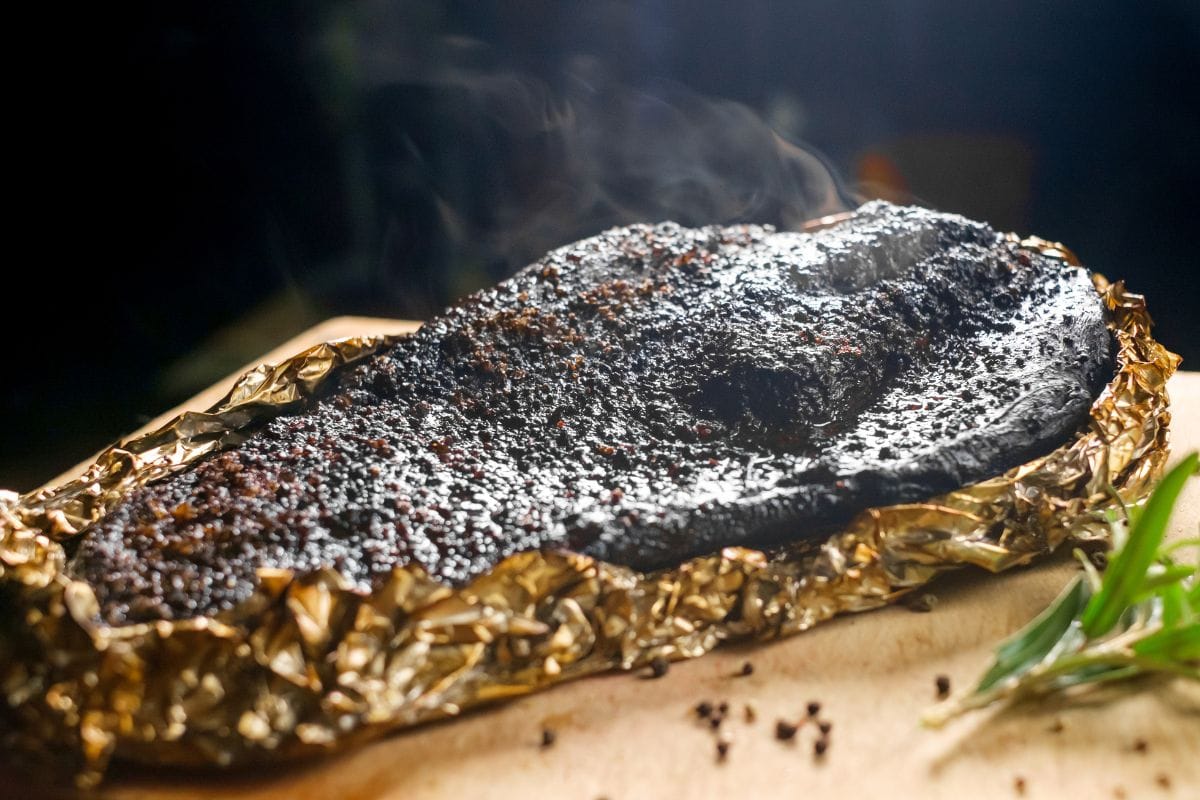
Here’s my go-to smoked beef brisket recipe. It is hands-off, very forgiving, and most importantly, a party pleaser! Let’s go:
As I always say, the best recipes are those that keep it simple. With that in mind, gather your ingredients in the following quantities:
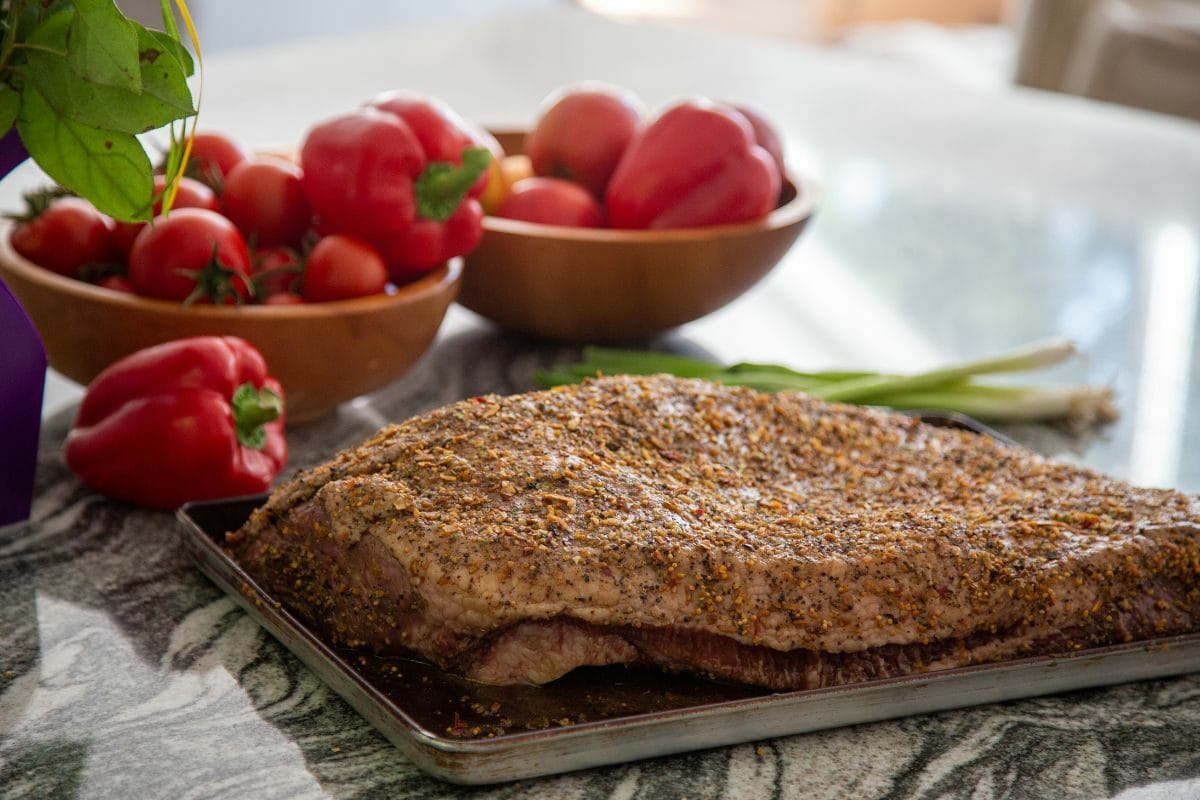
Smoked brisket is only as good as its rub. Start by mixing your spices in a mixing bowl and give it a stir. When blended, set aside.
Trim your brisket to get rid of excess fat and any loose meat. I highly recommend trimming brisket while it is still cold.
Cold briskets are much easier to slice and cut into. Room-temperature briskets are considerably harder to work with because the high fat content makes them slippery giving you a poor grip.
Once your brisket is trimmed, grab your aromatic spice mix and rub it generously throughout the surface of your meat. Make sure it gets into every nook and cranny of your brisket to get a delicious, evenly spiced bark.
Let your spiced brisket sit in the fridge for at least an hour before smoking. I let my spiced brisket sit in the fridge for up to 5 hours for an intense flavor. This allows the spice mix to penetrate the meat fibers and flavor the brisket.
Next up, get the fire going!
For best results, I suggest using indirect heat to cook large cuts of meat like beef brisket. Why? It facilitates slow cooking that typically lasts around 16 hours.
That is more than enough time for the fat to flavor the meat as it renders and the connective tissue to break down. Slow cooking yields tender, juicy, flavorful smoked beef brisket.
Get your smoker ready for indirect heat cooking using either the charcoal snake method or the minion method of coal arrangement. The fuel burns slowly for longer giving you a consistent fire that lasts for hours. Of course, the more fuel you use, the longer your fire will burn.
Now light the coal. I use Kingsford Charcoal Chimney Starter to get my fire going quickly. If that does not tickle your fancy, consider GBOF Starter Cubes. They are affordable and get the job done.
Top the fuel off with your favorite flavoring wood chips or chunks. I prefer the bold taste of Oklahoma Joe's Wood Chunks on my beef cuts. Preheat your smoker to 225 degrees and let it come to temp.
By the time your smoker is ready, the hardwood chips will have started smoldering. It is now the perfect time to place the brisket on the cooking grates.
Place your meat with the point end directly facing the fuel. This fatty end acts as an insulator. It is capable of taking heat without drying out.
Close the lid and let your meat smoke uninterrupted until the internal temperature gets to 165 degrees. It should take about 8 hours. No eyeballing here. Using a meat thermometer is the safest way to read meat temperature. If you are browsing for one, check out ThermaPro TP03 Digital Meat Thermometer. It is fast and accurate.
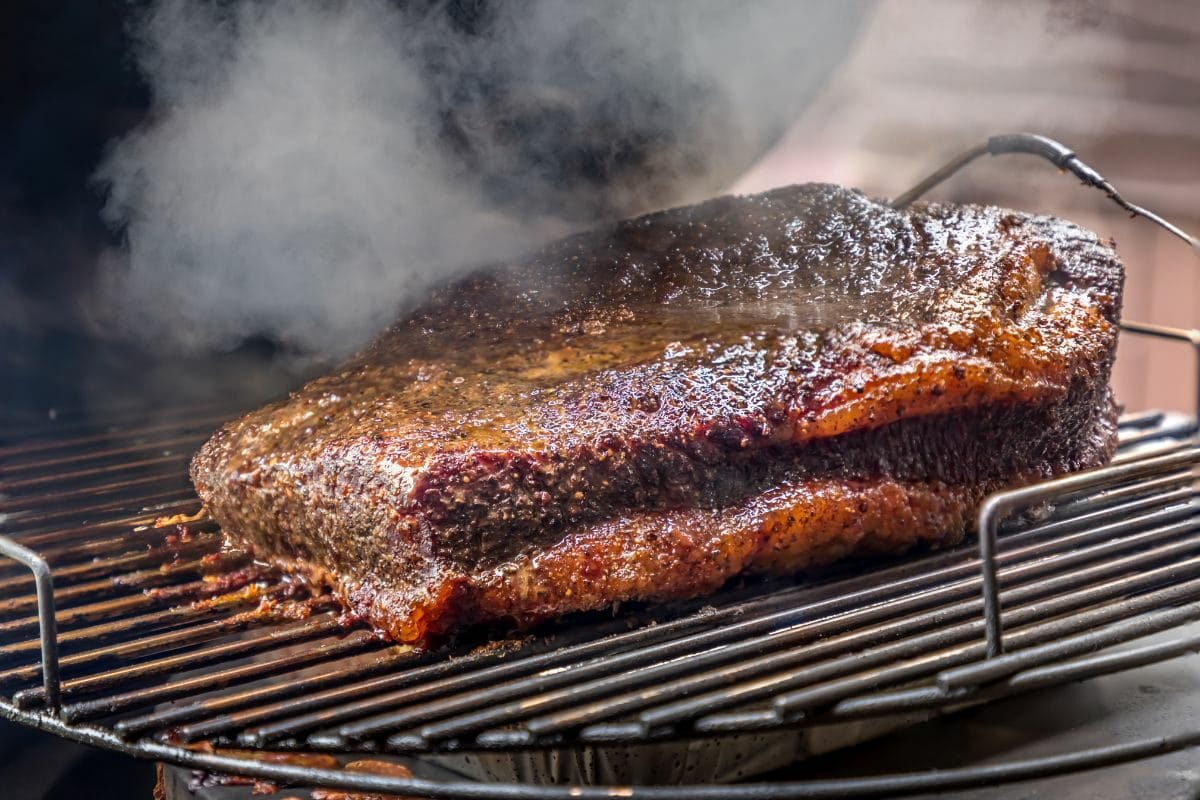
Now let’s tuck our partially cooked beef brisket into a Texas crutch.
It is important to mention that USDA calls for an internal temp of 145 degrees. However, at 145 degrees, the brisket is still tough and chewy indicating that the connective tissue has not been sufficiently broken down. If you want to serve fork-tender brisket, let your brisket cook till it gets to 203 degrees.
Some pitmasters prefer wrapping brisket in heavy-duty aluminum foil while others swear by pink butcher paper. My opinion? It comes down to the result you hope for.
Foil is the king of insulation meaning it reduces the total cook time. With foil, you can be sure the cooking temperature will not fluctuate. Additionally, all the fat and delicious juices dripping down your brisket will be reabsorbed back into the meat. Since this liquid has a better heat-carrying capacity, it creates a braising effect that makes the brisket incredibly tender and tasty.
The biggest drawback with foil is that because of its insulating capabilities, it gets your crust soggy and mushy. Additionally, smoke flavor cannot penetrate foil so you can forget having a badass smoke ring to show off.
Butcher paper is comparatively much more breathable and does not trap as much steam. This means it will keep your smoked meat moist without getting your bark soggy. More importantly, the brisket can absorb smoke.
The biggest drawback with butcher paper is that it can be challenging to achieve a tight wrap. This allows too much of the juices and steam to escape.
In a nutshell, if like me you have to get that crusty bark and a bold smokey flavor, butcher paper is the way to go. If not, using foil leaves you with delicious, flavor-packed drippings and very tender meat.
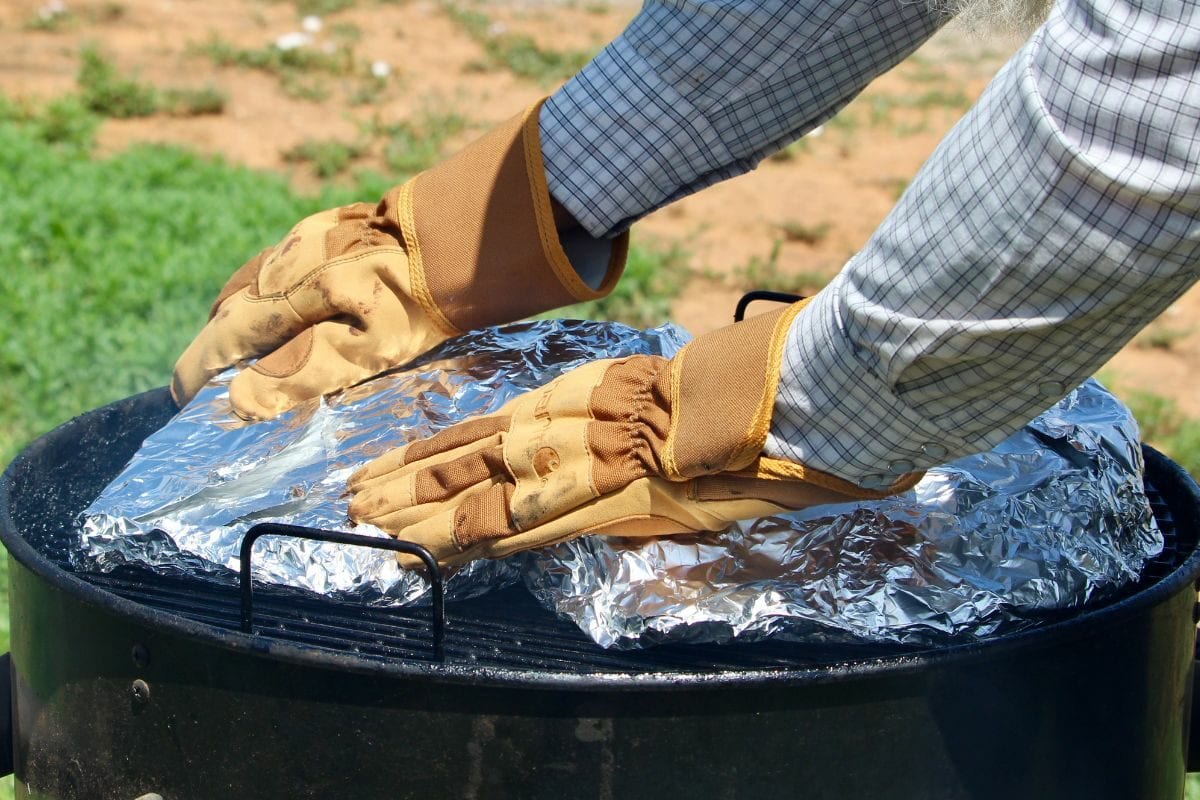
Just like with most cooking techniques in the BBQ world, the Texas crutch has its pros and cons. Here they are:
The BBQ stall refers to the ugly twilight zone when all cooking suddenly stops for hours on end. Normally, the meat stalls at 150-170 degrees. It is characterized by a stop in the rise of the internal temperature of your brisket. This is despite your BBQ skills and a beautiful fire.
Depending on several factors like the size of the meat, the stall can last for up to 6 hours. The culprit here is evaporative cooling. Evaporative cooling comes about when large cuts of meat like pork shoulder and briskets are cooked low and slow.
The meat contains moisture, right? This moisture starts to evaporate as the meat cooks. As we know, evaporation requires heat which can only come from the meat and the cooking chamber of your smoker.
This in turn lowers the temperature of the chamber and meat reaching a delicate balance that keeps the meat from getting any hotter. The meat stalls until it loses enough moisture to continue cooking.
In summary, while you are sweating over your smoker wondering where you messed up, your brisket is doing the same thing. Sweating.
Wrapping is pretty straightforward but we can always aim for perfection. Here are some tips:
To get the best smoked brisket, you must choose the right time to wrap it. Do not wrap your brisket too early or too late. Wrapping your brisket early keeps the meat from developing a high-quality bark and absorbing enough smoke. On the other hand, wrapping too late will not shorten the stall and will dry out your meat.
A good rule of thumb is to wrap the brisket when the internal temp of the brisket reaches 150-165 degrees.
Wrap the brisket tightly to reduce the amount of moisture lost to the surroundings especially if you are using a flavoring liquid. To that effect, go for good-quality aluminum foil or butcher paper that will not tear or leak.
I use Bryco Goods' Pink Butcher Paper because I am a sucker for a crunchy bark. However, if you want to trap more steam and baste the brisket with a flavoring liquid, consider Amazon Heavy Duty Aluminum foil.
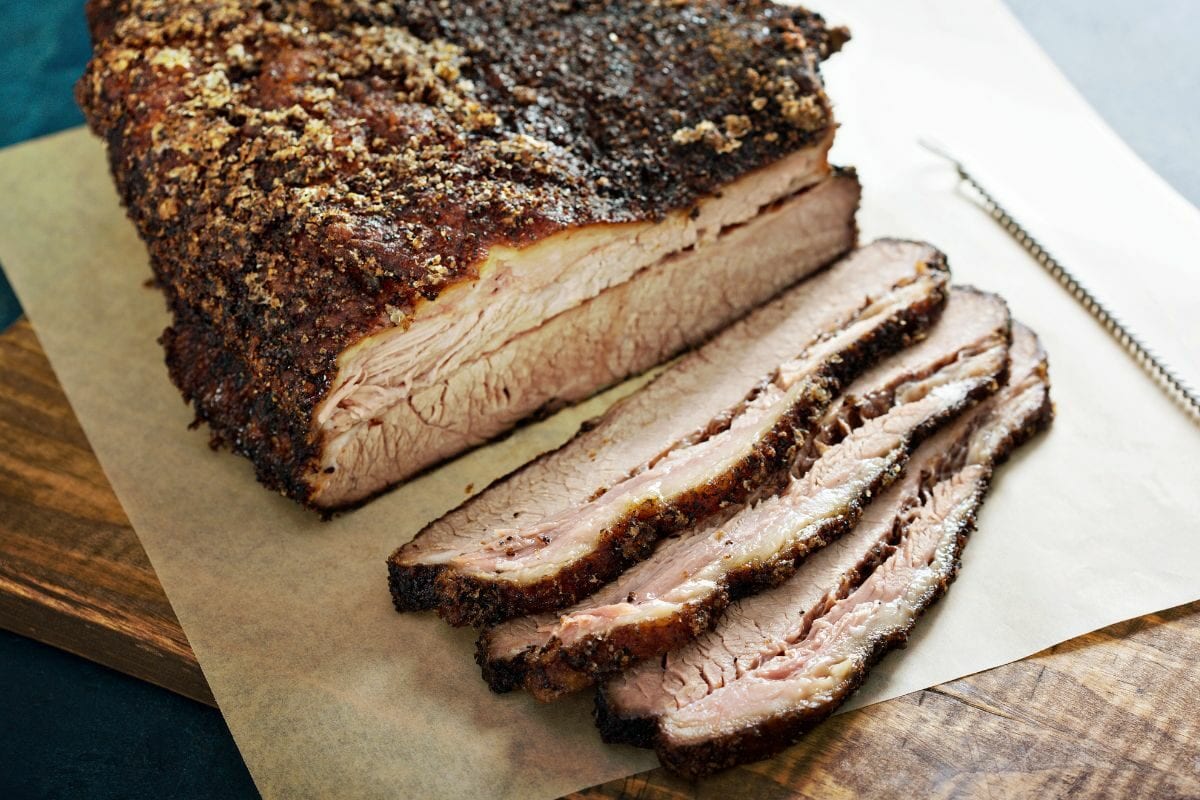
Keep a watchful eye on your meat temperature. The Texas crutch speeds up the cooking process by a few hours so it could be ready before you know it.
With the help of a reliable meat thermometer or digital probe, watch out for a done internal temp of 203 degrees.
Adding a flavoring liquid to your wrapped brisket goes a long way to elevate its taste and tenderness. The most popular liquid options include beef broth, apple juice, beer, red wine, vinegar, honey, melted butter, or even your favorite barbecue sauce.
I have had great results finishing my brisket on the grill when unwrapped. This works as a treat when you want to firm up the bark and get rid of the moisture buildup in the wrap right before you serve.
All you have to do is unwrap your brisket and put it on a preheated grill for 30 minutes at 300 degrees for up to 2 hours depending on how crispy you love your bark.
Lastly, rest your brisket before carving. Once your brisket is done, lay it on a cutting board for at least half an hour before slicing. This will allow the juices to be redistributed throughout the meat. That’s how you make sure each brisket slice is as juicy as the next.
If you cut into your smoked brisket right out of the smoker, all the juices will trickle down your work surface leaving you with a chewy brisket. The opposite of what you want.
Yes. I recommend crunching your brisket mainly to save time. If you bypass it, you will have to wait it out for about 6 hours. That’s enough time for either 3 movies or a drive from Los Angeles to San Francisco. Dreadful, right?
Crutch your brisket when it gets to an internal temp of 165 degrees. If you crutch it sooner than this, it will not have absorbed a sufficient amount of smoke. Wrapping it too late may dry out your meat making it too chewy to be the fireball of the party.
To recap, the Texas crutch mainly helps to bypass the meat stall which is a big problem when you are trying to smoke meat. Additionally, it ensures you end up with fork-tender, juicy beef brisket in considerably less time and using less fuel.
However, there is a catch. Two in fact. For starters, the Texas crutch inhibits smoke penetration and two, it softens the bark.
To balance out these factors, I recommend wrapping your brisket in a Texas crutch when it gets to an internal temperature of about 165 degrees. At this point, it has absorbed a good amount of smoke and has a dark, crusty bark. This has always worked for me.
My advice? The Texas crutch is not a cheat. It is a treat from the Lone Star State that takes your beef brisket great!